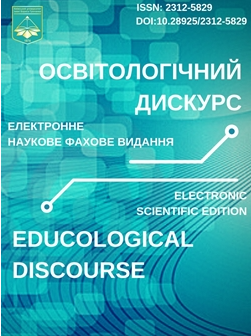Electronic Means of Communication as a Means of Remote Speech Therapy for Adult Stroke Survivors
DOI:
https://doi.org/10.28925/2312-5829.2023.15Keywords:
aphasia, apraxia, dysarthria, electronic means of communication, progressive apraxia of speech, strokeAbstract
The article discusses the types of strokes, general statistics and prevalence of strokes in the world and in Ukraine. The survey and tendencies to occurrence in younger people were carried out; the factors of stroke occurrence in young people have been studied. Statistics on the uneven distribution of strokes by gender were analyzed. It has been determined that women are at higher risk of suffering a severe or fatal stroke than men. The main reasons for such statistics are indicated. The main types of speech and language impairments that can occur after cerebral circulatory disorders are analyzed. The leading signs of aphasia, apraxia and dysarthria in adults have been identified. The definition of progressive apraxia of speech is revealed. It is established that these disorders occur due to damage to the language areas of the brain. The advantages of using electronic means of communication in speech-language therapy during quarantine restrictions and martial law in Ukraine are revealed. Software and messengers were characterised, such as Google Meet, Zoom, Teams, and Skype, that are used during distance and/or face-to-face sessions with a speech language pathologist. The main advantages of using these programs and the requirements for a speech language pathologist in the use of electronic means of communication are described. The concept of "social networks" and their impact on the rehabilitation of adult patients is revealed. The positive aspects of using social networks with adults during speech-language therapy, in particular Instagram and Facebook, are highlighted. Mobile applications are described as an additional means of restoring various aspects of speech, language and higher mental functions. It is noted that the current situation in the country, taking into account quarantine restrictions and martial law, can not provide full, continuous and quality speech language therapy in these cases, which leads to the conclusion that the lack of effectiveness of using exclusively traditional methods and techniques to compensate speech and language disorders caused by stroke, and encourages further search for ways to improve it by electronic means of communication. The author sees the need for a research aimed at studying the use of electronic means of communication in speech language therapy for people who have suffered a stroke.
Downloads
References
Katan, M., & Luft, A. (2018). Global Burden of Stroke. Semin Neurol, 38(2), 208-211. https://doi.org/10.1055/s-0038-1649503 (in English)
Goldstein, L. (2018). Primary prevention of ischemic stroke: a statement for healthcare professionals from the Stroke Council of the American Heart Association. Stroke, 32(1), 280-299. (in English)
Jackson, C., & Mishra, G. (2013). Depression and risk of stroke in midaged women: a prospective longitudinal study. Stroke, 44(6), 1555-1560. (in English)
Leffert, L., Clancy, G., Bateman, B., Bryant, A., & Kuklina, E. (2015). Hypertensive disorders and pregnancy-related stroke: frequency, trends, risk factors, and outcomes. Obstetrics and gynecology, 125(1), 124. (in English)
Shchehlov, D., Konotopchyk, S., & Pastushyn, O. (2022). Klinichnyi Protokol Likuvannia Khvorykh Na Ishemichnyi Insult [Clinical Protocol For Treatment Of Patients With Ischemic Stroke]. Ukrainska interventsiina neiroradiolohiia ta khirurhiia, 37(3), 14-56]. (in Ukrainian)
Mishchenko, M. (2020). Teoretychni aspekty vidnovlennia komunikatsii u doroslykh z afaziieiu, shcho perenesly insult. Aktualni pytannia korektsiinoi osvity (pedahohichni nauky): zbirnyk naukovykh prats, 16(1), 197-207 [Theoretical aspects of regaining communication in adults with aphasia after stroke] (in Ukrainian)
Valls Carbo, A., Reid, R. I., Tosakulwong, N., Weigand, S. D., Duffy, J. R., Clark, H. M., Utianski, R. L., Botha, H., Machulda, M. M., Strand, E. A., Schwarz, C. G., Jack, C. R., Josephs, K. A., & Whitwell, J. L. (2022). Tractography of supplementary motor area projections in progressive speech apraxia and aphasia. NeuroImage. Clinical, 34. https://doi.org/10.1016/j.nicl.2022.102999 (in English)
Duffy, J. (2019). Motor speech disorders e-book: Substrates, differential diagnosis, and management. Elsevier Health Sciences. (in English)
Sheremet M. Lohopediia. Vyd. dim "Slovo", 2014. [Speech therapy] (in Ukrainian)
Kovalenko, V. (2020, Zhovten). Osolyvosti korektsiino-rozvytkovoi roboty z molodshymy shkoliaramy iz zatrymkoiu psykhichnoho rozvytku v umovakh dystantsiinoho navchannia. Novitni tekhnolohii psykholoho–pedahohichnoho suprovodu ditei z osoblyvymy osvitnimy potrebamy v inkliuzyvnomu navchalnomu prostori zakladiv zahalnoi serednoi osvity [Conference session]. Vseukrainska naukovo-praktychna konferentsiia, Dnipro. [Features of correctional and developmental work with younger students with mental retardation in distance learning. The latest technologies of psychological and pedagogical support of children with special educational needs in the inclusive educational space of general secondary education institutions] (in Ukrainian)
Palii, S. (2013). Sotsialni merezhi yak zasib komunikatsii elektronnoho navchannia. Upravlinnia rozvytkom skladnykh system, 13, 152-156. [Social networks as a means of communication of e-learning] (in Ukrainian)
Truijen, S., Abdullahi, A., Bijsterbosch, D., van Zoest, E., Conijn, M., Wang, Y., Struyf, N., & Saeys, W. (2022). Effect of home-based virtual reality training and telerehabilitation on balance in individuals with Parkinson disease, multiple sclerosis, and stroke: a systematic review and meta-analysis. Neurological sciences : official journal of the Italian Neurological Society and of the Italian Society of Clinical Neurophysiology, 43(5), 2995–3006. https://doi.org/10.1007/s10072-021-05855-2 (in English)
Google Meet Retrieved from: https://support.google.com/meet/?hl=uk#topic=7306097
ZOOM Retrieved from: https://zoom.us/
Microsoft Teams Retrieved from: https://www.microsoft.com/uk-ua/education/products/teams
Skype Retrieved from: https://www.skype.com/uk/
Published
How to Cite
Issue
Section
License
Copyright (c) 2023 Educological discourse

This work is licensed under a Creative Commons Attribution-NonCommercial 4.0 International License.
Автори зберігають за собою всі авторські права та одночасно надають журналу право першої публікації на умовах лізенції Creative Commons Attribution-NonCommercial-ShareAlike 3.0 Unported License, що дозволяє розповсюджувати даний матеріал із зазначенням авторства та первинної публікації в даному журналі.





















